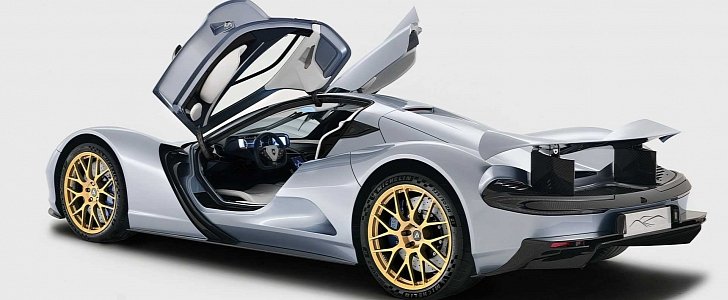Described as “the fastest-accelerating car” in the world, the Aspark Owl is much obliged to hit 60 miles per hour in 1.69 seconds. Thanks to four electric motors – one for each wheel – the performance specifications also include a top speed of 249 mph (400 km/h) with the active rear spoiler retracted into the bodywork.
Developed to come out at 93 mph (150 km/h) then lower itself back at speeds under (62 mph) 100 km/h, this spoiler is only a part of the active aerodynamics. Ride height adjustment and the low-drag configuration also help, but then again, all of these would be for nothing if Aspark wouldn’t have gifted the Owl with 2,012 horsepower.
Torque is similarly impressive, rated at 1,475 pound-feet. That’s the equivalent to 2,000 Nm or more than three 6.4-liter HEMI V8 engines working in unison. Another secret to the blistering performance of the Japanese hypercar is overall weight. 1,900 kilograms (4,189 pounds) dry is nothing short of impressive given the footprint of the Owl, and also impressive is the €2.9 million starting price.
The only thing that comes as disappointing is the battery’s capacity, limited by the extreme packaging. You’re looking at 64 kWh and 800 volts, which is enough for the Aspark to drive 280 miles (450 kilometers) on the New European Driving Cycle. There’s no denying the WLTP and EPA ratings are lower, but still, dailying this e-hypercar is out of the question for extremely obvious reasons.
10- and 4-piston carbon-ceramic brakes, double wishbone suspension at the front and rear, “Falcon Wing” doors, and four driving modes are also featured, along with 50 liters or 850 by 530 by 130 millimeters of luggage capacity. The ground clearance is extremely low too, namely from 80 to 160 millimeters.
“It was a big challenge to meet the aggressive targets of the Owl,” said chief exec Masanori Yoshida. “But with the 14 years of automotive engineering know-how and with great support from our Japanese and Italian collaborators, we overcame all [challenges].“ The head honcho has also declared that the Owl will be followed by “many exciting projects.”
Torque is similarly impressive, rated at 1,475 pound-feet. That’s the equivalent to 2,000 Nm or more than three 6.4-liter HEMI V8 engines working in unison. Another secret to the blistering performance of the Japanese hypercar is overall weight. 1,900 kilograms (4,189 pounds) dry is nothing short of impressive given the footprint of the Owl, and also impressive is the €2.9 million starting price.
The only thing that comes as disappointing is the battery’s capacity, limited by the extreme packaging. You’re looking at 64 kWh and 800 volts, which is enough for the Aspark to drive 280 miles (450 kilometers) on the New European Driving Cycle. There’s no denying the WLTP and EPA ratings are lower, but still, dailying this e-hypercar is out of the question for extremely obvious reasons.
10- and 4-piston carbon-ceramic brakes, double wishbone suspension at the front and rear, “Falcon Wing” doors, and four driving modes are also featured, along with 50 liters or 850 by 530 by 130 millimeters of luggage capacity. The ground clearance is extremely low too, namely from 80 to 160 millimeters.
“It was a big challenge to meet the aggressive targets of the Owl,” said chief exec Masanori Yoshida. “But with the 14 years of automotive engineering know-how and with great support from our Japanese and Italian collaborators, we overcame all [challenges].“ The head honcho has also declared that the Owl will be followed by “many exciting projects.”















